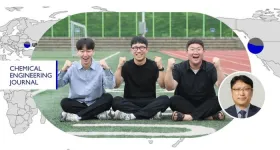(Press-News.org) LAWRENCE — Many of us know all too well the addictive nature of many foods marketed in the United States — most call it “junk food.” In fact, this kind of salty, sweet and high-fat fare makes up the lion’s share of what’s marketed to Americans.
Researchers employ a more scholarly term for food items featuring purposely tempting combinations of salts, fats and sugars: They’re “hyperpalatable.”
Now, an investigator at the University of Kansas has conducted research showing food brands owned by tobacco companies — which invested heavily into the U.S. food industry in the 1980s — appear to have “selectively disseminated hyperpalatable foods” to American consumers.
The study was published today in the peer-reviewed journal Addiction.
“We used multiple sources of data to examine the question, ‘In what ways were U.S. tobacco companies involved in the promotion and spread of hyperpalatable food into our food system?’” said lead author Tera Fazzino, assistant professor of psychology at KU and associate director of the Cofrin Logan Center for Addiction Research and Treatment at the KU Life Span Institute. “Hyperpalatable foods can be irresistible and difficult to stop eating. They have combinations of palatability-related nutrients, specifically fat, sugar, sodium or other carbohydrates that occur in combinations together.”
Fazzino’s previous work has shown today that 68% of the American food supply is hyperpalatable.
“These combinations of nutrients provide a really enhanced eating experience and make them difficult to stop eating,” she said. “These effects are different than if you just had something high in fat but had no sugar, salt or other type of refined carbohydrate.”
Fazzino and her co-authors found between 1988 and 2001, tobacco-owned foods were 29% more likely to be classified as fat-and-sodium hyperpalatable and 80% more likely to be classified as carbohydrate-and-sodium hyperpalatable than foods that were not tobacco-owned.
The KU researchers used data from a public repository of internal tobacco industry documents to determine ownership of food companies, then combed nutrition data from the U.S. Department of Agriculture in longitudinal analyses to estimate how much foods were “formulated to be hyperpalatable, based on tobacco ownership.”
“The question about their intent —we can’t really say from this data,” Fazzino said. “But what we can say is there’s evidence to indicate tobacco companies were consistently involved with owning and developing hyperpalatable foods during the time that they were leading our food system. Their involvement was selective in nature and different from the companies that didn’t have a parent tobacco-company ownership.”
Fazzino’s co-authors were KU doctoral students Daiil Jun and Kayla Bjorlie, along with Lynn Chollet Hinton, assistant professor of biostatistics and data science at KU Medical Center.
The KU researchers said they built their investigation inspired by earlier work by Laura Schmidt at the University of California-San Francisco.
“She and her team established that the same tobacco companies were involved in the development and heavy marketing of sugary drinks to kids — that was R.J. Reynolds — and that Philip Morris was involved in the direct transfer of tobacco marketing strategies targeting racial and ethnic minority communities in the U.S. to sell their food products,” Fazzino said.
While tobacco companies divested from the U.S. food system between the early to mid-2000s, perhaps the shadow of Big Tobacco has remained. The new KU study finds the availability of fat-and-sodium hyperpalatable foods (more than 57%) and carbohydrate-and-sodium hyperpalatable foods (more than 17%) was still high in 2018, regardless of prior tobacco ownership, showing these foods have become mainstays of the American diet.
“The majority of what’s out there in our food supply falls under the hyperpalatable category,” Fazzino said. “It’s actually a bit difficult to track down food that’s not hyperpalatable. In our day-to-day lives, the foods we’re surrounded by and can easily grab are mostly the hyperpalatable ones. And foods that are not hyperpalatable, such as fresh fruits and vegetables – they’re not just hard to find, they’re also more expensive. We don’t really have many choices when it comes to picking between foods that are fresh and enjoyable to eat (e.g., a crisp apple) and foods that you just can’t stop eating.”
Fazzino said using metrics of hyperpalatability could be one way to regulate formulations of food that are engineered to induce sustained eating.
“These foods have combinations of ingredients that create effects you don’t get when you eat those ingredients separately,” the KU researcher said. “And guess what? These combinations don’t really exist in nature, so our bodies aren’t ready to handle them. They can excessively trigger our brain’s reward system and disrupt our fullness signals, which is why they’re difficult to resist.”
As a result, consumers of hyperpalatable foods are more prone to obesity and related health consequences, even when they don’t intend to overeat.
“These foods may be designed to make you eat more than you planned,” Fazzino said. “It’s not just about personal choice and watching what you eat – they can kind of trick your body into eating more than you actually want.”
END
Study shows food from tobacco-owned brands more 'hyperpalatable' than competitor's food
2023-09-08
ELSE PRESS RELEASES FROM THIS DATE:
What do neurons, fireflies and dancing the Nutbush have in common?
2023-09-08
Computer scientists and mathematicians working in complex systems at the University of Sydney and the Max Planck Institute for Mathematics in the Sciences in Germany have developed new methods to describe what many of us take for granted – how easy, or hard, it can be to fall in and out of sync.
Synchronised phenomena are all around us, whether it is human clapping and dancing, or the way fireflies flash, or how our neurons and heart cells interact. However, it is something not fully understood in engineering and science.
Associate Professor Joseph Lizier, expert in complex systems at the University of Sydney, said: “We know ...
Drug approvals in clinical trials were correlated with the cells/humans discrepancy in gene perturbation effects
2023-09-08
Developing new drugs is paramount in discovering innovative treatments and preventing diseases. This is vital not only for advancing medicine but also for the overall health and well-being of humanity. Yet, even when drugs demonstrate safety and efficacy in cell and animal models, they frequently encounter hurdles in clinical trials on human.
A single setback for a drug during clinical trials, which involves diverse population groups, can result in significant economic losses. To address this, it is imperative to understand why certain drugs, despite passing the preclinical stages, falter during clinical ...
Unveiling the causes of the 1931 Yangtze River Deluge
2023-09-08
In the summer of 1931, an unprecedented calamity unfolded along the Yangtze River basin in eastern China - the 1931 Yangtze River flood, known as one of history's deadliest natural disasters. This cataclysmic event submerged a staggering 180,000 km2, affected 25 million lives, and tragically claimed over 2 million lives.
Despite its immense societal impact, the origins of this monumental flood have remained largely unexplored, a challenge compounded by the scarcity of historical records and pre-1950s meteorological data in China. Recent access to crucial historical datasets has, however, unlocked the ability to investigate the 1931 Yangtze River flood.
A recent study published ...
Physical activity boosting resources support classroom performance
2023-09-08
DALLAS, September 8, 2023 — This back to school season the American Heart Association and the National Football League (NFL), in collaboration with its 32 NFL clubs, are offering students exciting ways to move more with NFL PLAY 60™. Physical activity is important as students return to the classroom. According to the U.S. Department of Health and Human Services’ 2018 Physical Activity Guidelines for Americans, active kids learn better, focus more, think more clearly, react to stress more calmly, and perform and behave better in the classroom[1].
The ...
New study highlights feasibility and optimization of ammonia-based power generation for carbon neutrality
2023-09-08
Ammonia is emerging as a promising energy source to achieve carbon neutrality due to its inherent carbon-free nature. A recent study, led by Professor Hankwon Lim in the School of Energy and Chemical Engineering and the Graduate School of Carbon Neutrality at UNIST, has evaluated the feasibility of ammonia-based power generation through techno-economic and carbon footprint analyses. The research focuses on an integrated system combining ammonia decomposition and phosphoric acid fuel cells.
The study, conducted using a commercial process simulator, unveils significant findings regarding the efficiency and economic viability of utilizing ammonia ...
UTSA researchers explain plant’s medicinal power against COVID and glioblastoma
2023-09-08
Vibrant green leaves sprout from tall fragrant plants sitting neatly in two rows of terracotta pots in Valerie Sponsel’s UTSA biology laboratory. One floor just above her is the chemistry lab of Francis Yoshimoto, who is extracting the plant’s leaves for medicinal compounds. Soon, the researchers will meet with UTSA researcher Annie Lin, who will test the extracted compounds on cancer cells.
The plant is Artemisia annua, or Sweet Annie, and it contains medicinal compounds. UTSA researchers are studying the plant to understand the bioactive properties of one of these compounds, Arteannuin B, in cancer cells and COVID, the ...
Benchtop NMR spectroscopy can accurately analyse pyrolysis oils
2023-09-08
Benchtop NMR spectroscopy can accurately analyse pyrolysis oils
Pyrolysis bio-oils have the potential to be widely used as alternative fuels but are very complex to analyse
Cheaper, simpler, low-field, or ‘benchtop’, NMR spectrometers were able to accurately quantify key oxygen-containing components of pyrolysis bio-oils for the first time
More accessible analysis could help develop the potential of bio-oils as an alternative to fossil fuels
EMBARGOED UNTIL FRIDAY 8TH SEPTEMBER at 9am UK time 2023 | Birmingham, UK
A team of researchers at Aston University ...
The climate crisis could reshape Italian mountain forests forever
2023-09-08
As a result of the climate crisis, future forests may become unrecognizable. Trees that currently make up European woods may no longer be seen — or they may have moved several hundred meters uphill. Scientists writing in Frontiers in Forests and Global Change have mapped the forests of five vulnerable mountain areas in Italy and modelled the future of these fragile ecosystems.
“If I imagine my daughter walking with me as an old man, in our mountain forests, I can imagine that we can see the initial stage of a profound ...
Disney princesses can be good for a child’s self-image, UC Davis researchers suggest
2023-09-08
Children have loved Disney princesses since Snow White and the Seven Dwarfs premiered in theaters in 1937. While this adoration continues to grow in terms of princess movie ratings, some parents may wonder what effects these idealized images of young women might have on how their children feel about and express themselves.
According to new research from the University of California, Davis, a favorite princess improved — but did not harm — young children’s ...
University of Miami upgrades Atmospheric Chemistry Observatory in Barbados
2023-09-08
The observatory has been used to document the transport of Saharan dust particles across the Atlantic Ocean to the Caribbean, creating the longest-running dust data set in existence. Scientists from many different disciplines use the data to understand how dust particles impact everything from coral reef health to cloud formation and tropical storms.
Through a grant from the National Science Foundation (NSF), the University of Miami Rosenstiel School of Marine, Atmospheric, and Earth Science recently completed a major upgrade to its Barbados Atmospheric Chemistry Observatory (BACO), expanding its capability ...






